About 40 years ago, I bought a Howa 30 06 barreled action and a Bishop semi-inletted stock. It was to be the first rifle I had stocked and I wanted something different. In perusing the Bishop catalog, I selected cherry instead of walnut (not cherry as in cool, but cherry as in the kind of tree George Washington cut down). When I ordered it on the phone (this was way before the Internet came along), I asked the Bishop people if they could run the forearm out to the muzzle, because my concept was to make it like a Mannlicher rifle. I thought that would be cool (and I was right). As I recall, the semi-inletted stock was $57 plus postage (and postage wasn’t very much). Ah, times change.
Semi-inletted stocks were advertised as 95% complete. All you had to do, the ads said, was some minor finishing work to get a perfect fit (sanding and maybe a little filing in the stock’s inletted areas so the barreled action would drop in). But it took a ton of labor to make that happen. Maybe I just didn’t know what I was doing, but if what I put into the stock’s final inletting was 5%, Bishop must have spent a million hours doing the first 95%. But all’s well that ends well and this project ended well.
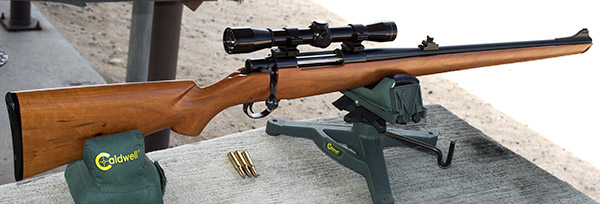
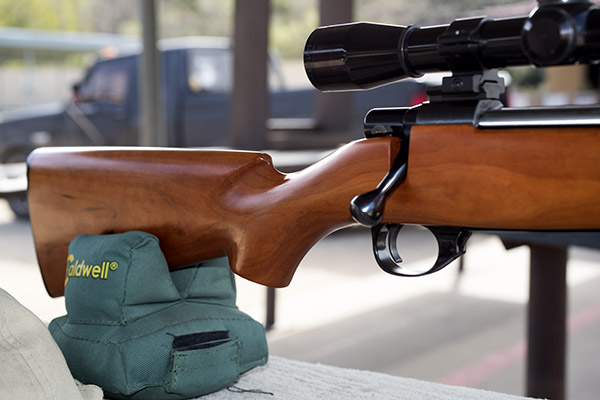

I finished the stock with what would become my preferred finish on all future gun projects, and that’s TruOil. After sanding with 320, then 400, and then 600 grit paper, and then buffing the wood with denim to get any remaining grain whiskers, the drill was to apply a coat of TruOil, wait a day for it to dry, beat it down with 0000 steel wool, and repeat the process the following day. You’re looking at 10 days of that on this stock. It deepened the color of the cherry nicely. It’s different, and it always causes folks who see it at the range to strike up a conversation.
I floated the barrel (that means sanding the barrel channel so the barrel doesn’t touch the stock at all) and glass-bedded the action (that means pouring an epoxy and fiberglass mix into the stock and allowing it to cure around the receiver, creating a perfect bed for the action). Glass bedding creates a stable platform. Free floating the barrel eliminates asymmetric loads on the barrel due to temperature and humidity changes, and temperature changes in the barrel that occur when a rifle is fired. Those two steps improve accuracy tremendously. It works.
I wanted something different for the forearm tip on this rifle, and I didn’t want to screw around with trying to fit a metal cap (what you typically see on a Mannlicher stock) because that would bring the barrel back into contact with the wood. I thought it would be cool to give it an Alex Henry forearm treatment (like the Ruger No. 1 style), and I carved it freehand with a Dremel. That turned out surprisingly well, too.

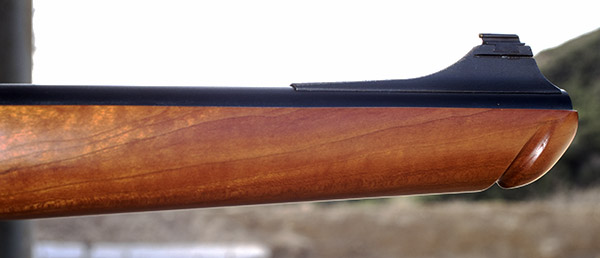
I didn’t checker the stock. There are two reasons for that…I can’t checker worth a damn, and I actually prefer the look of a rifle without checkering.
Three handloads I developed for use in other 30 06 rifles work well. The first is a near-max load of IMR 4320 with the Hornady 130-grain jacketed soft point bullet (that one shoots 1-inch groups all day long in a Ruger No. 1), the second is a couple of grains under max of IMR 4064 with either the Winchester or Hornady 150-grain jacketed soft point (both bullets work equally well, and this load is a tack driver in my Model 70), and the third is a max IMR 4064 load with the Remington 180-grain jacketed soft point (that’s the accuracy load in my Browning B-78).
Every rifle has a load it prefers, though, and this custom Howa is no exception. Here’s the secret sauce:
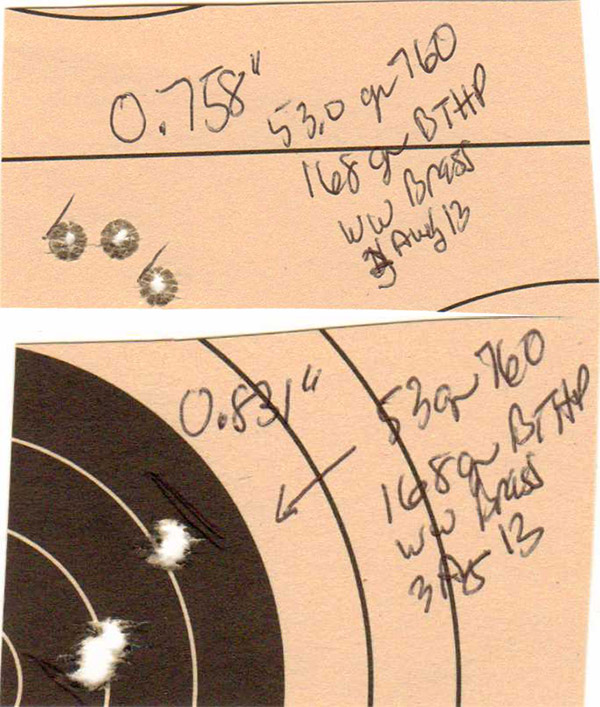
The load shown in the photos above is not a hunting load (the Sierra Matchkings would sail right through an animal without much expansion), but it sure is accurate and it doesn’t take much to kill a paper target. I like to think my marksmanship has improved with age; I probably ought to find some 760 powder and load a few more to see if I could better the groups you see above.
In the 1960s and 1970s (and on into the 1980s), there used to be several companies offering semi-inletted rifle stocks, but that business has largely gone away. There’s still Richard’s Microfit in the Valley; I used them for a .375 Ruger project I did about 5 years ago (and I could go there and personally select the wood I wanted).
Some of the gunstock companies were mismanaged and took shortcuts that bankrupted them, but I think the real reasons they folded fall into two categories. The first is that not many people want to expend the effort it takes to create a custom rifle like the one you see here, and most folks don’t have the skills to do so. Shop courses disappeared in the US a long time ago, and most people today are more adept at things like at operating a cell phone and posting on Facebook.
Another reason is that very few people want a rifle with real wood. Black plastic is all the rage. I was on the range last week, it was fairly busy, and I was literally the only guy shooting a rifle that didn’t have a Tupperware stock (everyone fancies themselves an operator; few have ever worn a uniform). Not that there’s anything wrong with that if a modern military rifle is what floats your boat, and there are some fine custom builds (as outlined in Jake Lawson’s blog last week).
Hell, even if you wanted to build a custom rifle like the one you see here, it’s hard to find a barreled action. In the 1970s it was not unusual for rifle companies to sell barreled actions; today, the only outfit I know of that does so is Howa and you don’t see them too often. If you come across one, let me know. I could go for another project.
More Tales of the Gun stories!

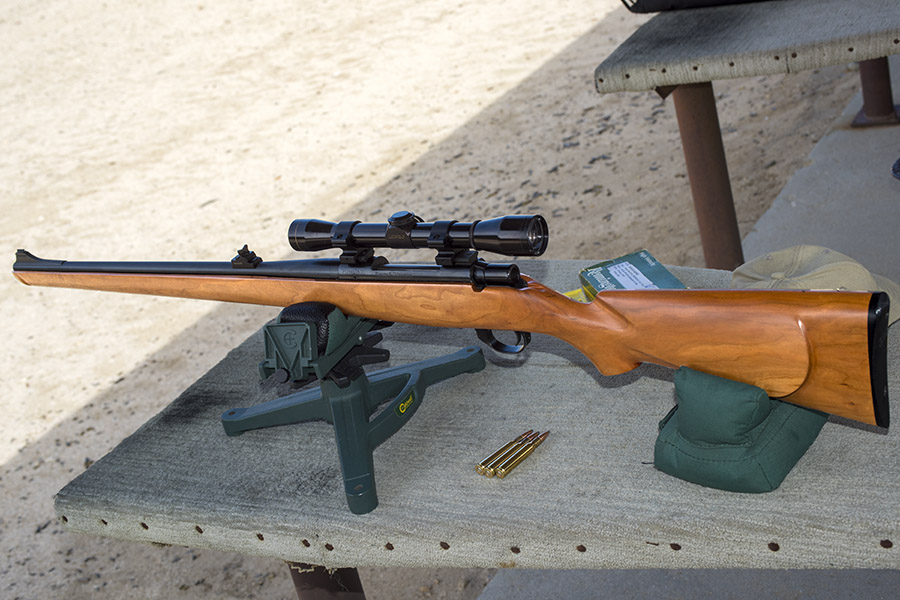
Beautiful finish on that rifle, well done
Muchas gracias, Don Larry!
After you glass bed an action in how do you get it out? I’m assuming that once you apply the bedding material and install the action into it you leave it there until it cures. So does that essentially glue the action to the stock? And what do you do if you need to separate them? BTW – nice rifle!!! Single shot or box mag? And do you use it for target only or take it hunting too?
Ah, good question, Bob, and one I’ll probably do a blog on the next time I glass bed an action. I considered explaining this in the blog posted today, but I didn’t because I thought it would make it too long. Basically, you coat the barreled action with a release agent. I apply two coats of the release agent, allowing each to dry, and the trick is to make sure every bit of metal that contacts the epoxy is covered with the release agent. If you don’t, you’ll have glued the barreled action into the stock permanently, and you don’t want that. You are correct; you allow the epoxy to cure overnight. The next day you can pop the barreled action out of the stock. The first time you remove the barreled action, the epoxy wants to hang on to it and it’s always a tense moment until action pops out. But it always has. I’ve done this on many rifles. It always improves accuracy.
Regarding your other questions: The rifle has a box magazine that holds three rounds, I think, but I usually only load one when I’m at the range. I haven’t hunted with this rifle. When I hunt, I have three rifles that see all the fun. One is a maple-stocked Model 70 Winchester (in 30 06), another is a Ruger No. 1 I bought in 1976 (also a 30 06), and the third is a custom-barreled Weatherby Mk V in .300 H&H. I glass bedded the Weatherby and that puppy has shot quarter-inch groups.
Funny how what was bleeding-edge tech has become the hallmark of bygone craft.
That’s a lovely piece of work, Joe. Patience rewarded!
High praise indeed. Again, muchas gracias.